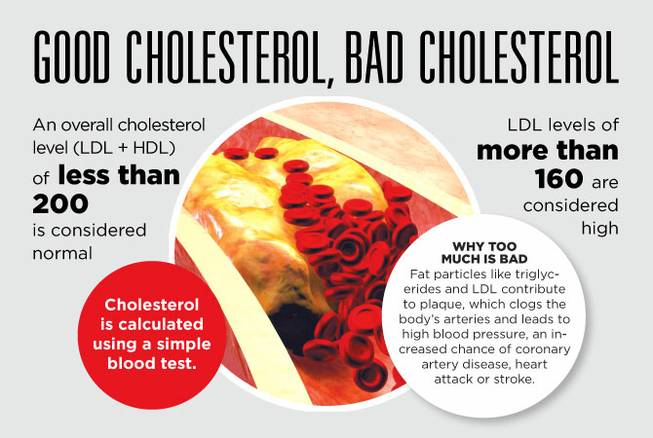
Sunday, Aug. 9, 2015 | 2 a.m.
Most people know high cholesterol is bad for your health. But you may not know cholesterol levels can be too low, which also could result in serious health issues. “Cholesterol is important — it’s a vital element of the body,” said Dr. Nayab Zafar, an interventional cardiologist at Sunrise Hospital and Medical Center. “Like any other substance in the body, a low or high level of cholesterol – an imbalance – can affect the body in a negative way.”
What is cholesterol?
Cholesterol is a lipid, a kind of fat used by the body. It is present in all of the body’s cells because it forms the cell membrane, the outer wall of each cell. “It ensures proper functioning of nerve tissues, regulates the digestion of food and helps synthesize hormones, which regulate various bodily functions,” Zafar said.
How the body processes cholesterol
1. The liver makes a large share of the body’s cholesterol from saturated fats or animal fats consumed.
2. Particles called lipoproteins carry the fats, including cholesterol and triglycerides, to where they’re needed in the body via the bloodstream.
The two most important lipoproteins for calculating cholesterol levels are ...
HDL, or high-density lipoproteins and LDL, or low-density lipoproteins.
HDL can help lower cholesterol levels and take fat out of arteries.
Sometimes, the body processes LDL into artery-clogging plaque. That’s why cholesterol carried by HDL is known as “good cholesterol” and LDL cholesterol is known as “bad cholesterol.”
Cholesterol levels are calculated using a simple blood test.
Good levels: Overall cholesterol level (LDL + HDL) less than 200
Bad levels: LDL LEVEL more than 160
Why too much is bad
Fat particles such as triglycerides and LDL contribute to plaque, which clogs the body’s arteries and can lead to high blood pressure, an increased chance of coronary artery disease, heart attack or stroke.
Total daily cholesterol consumption should be less than 200 mg.
Where can I find good cholesterol?
Fish, such as salmon and black cod, are good sources of healthy fats. Eating high-fiber foods and replacing traditional cooking oil with olive oil or avocado oil also can help.
°°°
If you have other risk factors, your cholesterol standards are different.
How high is too high? It’s a tricky question. What makes a person’s cholesterol too high depends on factors such as ethnicity, age and health history.
High cholesterol can be calculated as the level of cholesterol carried by LDL or as total cholesterol levels. In general, if your LDL cholesterol is greater than 160, it’s too high. But there are risk factors that lower that threshold.
“If you have diabetes, high blood pressure, a history of coronary artery disease, or if you’re a smoker or a woman older than 50, LDL greater than 130 is bad,” Dr. Nayab Zafar said. “If you’ve had a heart attack already, LDL greater than 100 is considered bad."
Depending on your ethnicity, you might have a higher risk of high cholesterol.
“More westernized nations with less physical activity end up with higher cholesterol levels,” Zafar said. “In the United States, Hispanic and African-American populations are more prone to overall higher cholesterol level. South Asians have a genetic deficiency of healthy HDL cholesterol, while the Caucasian population is more prone to high levels of unhealthy LDL cholesterol.”
°°°
Risk factors
The biggest risk factors for high cholesterol among Americans are poor diet, a lack of exercise and smoking. “You want a balanced diet where bad fats — trans fats or saturated fats — form less than 7 percent of total caloric intake for a person,” Zafar said.
Medication
Though the best first step is lifestyle modification, doctors often presecribe a family of medications called statins to block cholesterol production and help reduce high cholesterol.
Every adult needs to be checked
Statistically, your risk of high cholesterol goes up sharply as you age. At 20 years old, about 20 percent of the U.S. population has high cholesterol. By age 40, half of the population has high cholesterol. That means “everyone and anyone who’s an adult needs their levels checked,” Zafar said.
What about low cholesterol?
Low cholesterol is the rarer form of cholesterol imbalance, and some doctors may not recognize the effects, Zafar said.
Because of the liver’s important role in cholesterol production, it’s a two-way street: The liver can contribute to low cholesterol, and low cholesterol can affect the liver. Low cholesterol may contribute to liver disease, and people with liver disease may end up with low cholesterol.
Low cholesterol could lead to difficulty absorbing vital nutrients such as vitamin D, skin problems and hair loss. In women who are pregnant, low cholesterol can lead to pre-term delivery or low birth weight.
A cholesterol deficiency even can affect mental health. “Cholesterol helps facilitate nerve and neuron conduction in a better way,” Zafar said. “Cholesterol also helps regulate hormones. Both those factors could lead to mental illnesses like depression or anxiety.”

Join the Discussion:
Check this out for a full explanation of our conversion to the LiveFyre commenting system and instructions on how to sign up for an account.
Full comments policy